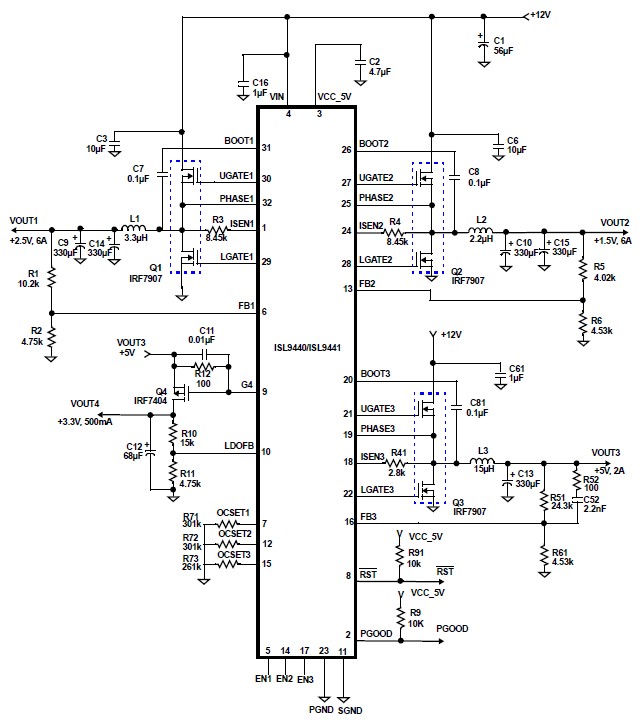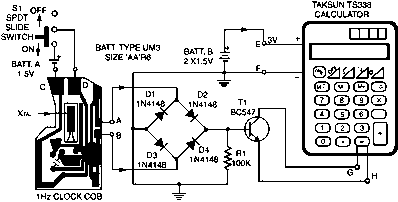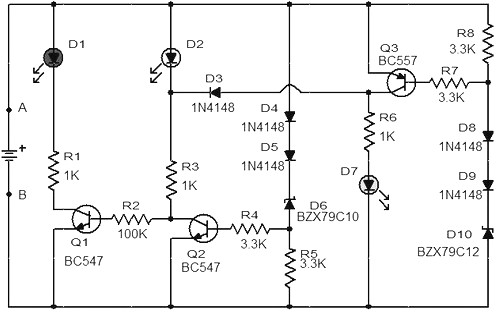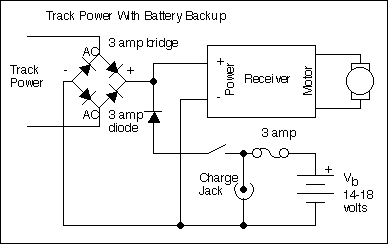
ISL9440 quad output circuit power supply design

The ISL9440 quad-output synchronous buck controller IC can be utilized to design a highly efficient electronic circuit power supply that delivers four distinct fixed output voltages. The ISL9440 integrates three PWM controllers and one low dropout linear regulator controller, providing a comprehensive solution for multi-rail power applications in devices such as cable and satellite set-top boxes, VoIP gateways, cable modems, and various home connectivity products, as well as for industrial and general-purpose applications. This power supply project featuring the ISL9440 includes internal soft-start functionality, independent enable inputs for simplified supply rail sequencing, and integrated under-voltage, over-voltage, over-current, and over-temperature protections, all within a compact 5mm x 5mm QFN package. The quad-output circuit utilizes internal loop compensation, minimizing the need for peripheral components to achieve a compact design and a low total solution cost. The device employs current mode control with feed forward capabilities to accommodate diverse applications, even with fixed internal compensations. This quad-output circuit power supply requires a 12-volt DC input and provides the following output voltages: 1. 5 volts at 6 amperes, 2. 5 volts at 6 amperes, 5 volts at 2 amperes, and 3.3 volts at 0.5 ampere. The schematic for this quad-output electronic power supply project requires only a few external components, making it straightforward to design.
The ISL9440 quad-output synchronous buck controller is a versatile and efficient solution for power supply needs in various electronic applications. The device's architecture, featuring three PWM controllers and one LDO, allows for the simultaneous generation of multiple output voltages, which is particularly beneficial in systems requiring multiple power rails. The integrated protections (UV, OV, OC, OT) ensure reliable operation and safeguard the connected loads, enhancing the overall robustness of the power supply design.
The internal soft-start feature minimizes inrush current during power-up, which is crucial for preventing potential damage to sensitive components and ensuring a smooth startup sequence. The independent enable inputs facilitate precise control over the timing of each output voltage, allowing for tailored sequencing that can be critical in complex systems.
The compact 5mm x 5mm QFN package is advantageous for space-constrained applications, contributing to a lower PCB footprint while maintaining high performance. The current mode control with feed forward enhances transient response and stability, making the ISL9440 suitable for a wide range of load conditions.
The specified output voltages of 1.5V at 6A, 5V at 6A, 5V at 2A, and 3.3V at 0.5A cater to common requirements in consumer electronics and industrial applications. The low component count required for the design simplifies assembly and reduces overall system costs, making it an attractive option for engineers seeking efficient and reliable power supply solutions.
In summary, the ISL9440-based quad-output synchronous buck controller circuit stands out as a highly efficient, flexible, and compact power supply solution suitable for a broad spectrum of applications.Using the ISL9440 quad-output synchronous buck controller IC can be designed a very simple high efficiency electronic circuit power supply, that will provide 4 different fixed output voltages. ISL9440 synchronous buck controller circuit integrate 3 PWM controllers and 1 low drop-out linear regulator controller, which are full featured and designe
d to provide multi-rail power for use in products such as cable and satellite set-top boxes, VoIP gateways, cable modems, and other home connectivity products as well as a variety of industrial and general purpose applications. This electronic circuit power supply project based on the ISL9440 offer internal soft-start, independent enable inputs for ease of supply rail sequencing, and integrated UV/OV/OC/OT protections in a space conscious 5mmx5mm QFN package.
This quad output circuit power supply project based on ISL9440 utilize internal loop compensation to keep minimum peripheral components for compact design and a low total solution cost. These device are implemented with current mode control with feed forward to cover various applications even with fixed internal compensations.
This quad output circuit power supply require a 12 volt DC input voltage and will provide the following output voltages : 1. 5 volt at 6 amperes, 2. 5 volt at 6 amperes, 5 volt at 2 amperes and 3. 3 volt at 0. 5 ampere. As you can see in the schematic circuit, this quad-output electronic project power supply require few external electronic parts and is very easy to be designed.
🔗 External reference
The ISL9440 quad-output synchronous buck controller is a versatile and efficient solution for power supply needs in various electronic applications. The device's architecture, featuring three PWM controllers and one LDO, allows for the simultaneous generation of multiple output voltages, which is particularly beneficial in systems requiring multiple power rails. The integrated protections (UV, OV, OC, OT) ensure reliable operation and safeguard the connected loads, enhancing the overall robustness of the power supply design.
The internal soft-start feature minimizes inrush current during power-up, which is crucial for preventing potential damage to sensitive components and ensuring a smooth startup sequence. The independent enable inputs facilitate precise control over the timing of each output voltage, allowing for tailored sequencing that can be critical in complex systems.
The compact 5mm x 5mm QFN package is advantageous for space-constrained applications, contributing to a lower PCB footprint while maintaining high performance. The current mode control with feed forward enhances transient response and stability, making the ISL9440 suitable for a wide range of load conditions.
The specified output voltages of 1.5V at 6A, 5V at 6A, 5V at 2A, and 3.3V at 0.5A cater to common requirements in consumer electronics and industrial applications. The low component count required for the design simplifies assembly and reduces overall system costs, making it an attractive option for engineers seeking efficient and reliable power supply solutions.
In summary, the ISL9440-based quad-output synchronous buck controller circuit stands out as a highly efficient, flexible, and compact power supply solution suitable for a broad spectrum of applications.Using the ISL9440 quad-output synchronous buck controller IC can be designed a very simple high efficiency electronic circuit power supply, that will provide 4 different fixed output voltages. ISL9440 synchronous buck controller circuit integrate 3 PWM controllers and 1 low drop-out linear regulator controller, which are full featured and designe
d to provide multi-rail power for use in products such as cable and satellite set-top boxes, VoIP gateways, cable modems, and other home connectivity products as well as a variety of industrial and general purpose applications. This electronic circuit power supply project based on the ISL9440 offer internal soft-start, independent enable inputs for ease of supply rail sequencing, and integrated UV/OV/OC/OT protections in a space conscious 5mmx5mm QFN package.
This quad output circuit power supply project based on ISL9440 utilize internal loop compensation to keep minimum peripheral components for compact design and a low total solution cost. These device are implemented with current mode control with feed forward to cover various applications even with fixed internal compensations.
This quad output circuit power supply require a 12 volt DC input voltage and will provide the following output voltages : 1. 5 volt at 6 amperes, 2. 5 volt at 6 amperes, 5 volt at 2 amperes and 3. 3 volt at 0. 5 ampere. As you can see in the schematic circuit, this quad-output electronic project power supply require few external electronic parts and is very easy to be designed.
🔗 External reference





